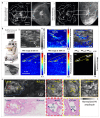Advances in Photoacoustic Imaging of Breast Cancer
- PMID: 40807976
- PMCID: PMC12349475
- DOI: 10.3390/s25154812
Advances in Photoacoustic Imaging of Breast Cancer
Abstract
Breast cancer is the leading cause of cancer-related mortality among women world-wide, and early screening is critical for improving patient survival. Medical imaging plays a central role in breast cancer screening, diagnosis, and treatment monitoring. However, conventional imaging modalities-including mammography, ultrasound, and magnetic resonance imaging-face limitations such as low diagnostic specificity, relatively slow imaging speed, ionizing radiation exposure, and dependence on exogenous contrast agents. Photoacoustic imaging (PAI), a novel hybrid imaging technique that combines optical contrast with ultrasonic spatial resolution, has shown great promise in addressing these challenges. By revealing anatomical, functional, and molecular features of the breast tumor microenvironment, PAI offers high spatial resolution, rapid imaging, and minimal operator dependence. This review outlines the fundamental principles of PAI and systematically examines recent advances in its application to breast cancer screening, diagnosis, and therapeutic evaluation. Furthermore, we discuss the translational potential of PAI as an emerging breast imaging modality, complementing existing clinical techniques.
Keywords: breast cancer; diagnostic accuracy; early screening; photoacoustic imaging; therapeutic evaluation.
Conflict of interest statement
The authors declare no conflicts of interest.
Figures




Similar articles
-
Prescription of Controlled Substances: Benefits and Risks.2025 Jul 6. In: StatPearls [Internet]. Treasure Island (FL): StatPearls Publishing; 2025 Jan–. 2025 Jul 6. In: StatPearls [Internet]. Treasure Island (FL): StatPearls Publishing; 2025 Jan–. PMID: 30726003 Free Books & Documents.
-
Management of urinary stones by experts in stone disease (ESD 2025).Arch Ital Urol Androl. 2025 Jun 30;97(2):14085. doi: 10.4081/aiua.2025.14085. Epub 2025 Jun 30. Arch Ital Urol Androl. 2025. PMID: 40583613 Review.
-
Photoacoustic imaging for cutaneous melanoma assessment: a comprehensive review.J Biomed Opt. 2024 Jan;29(Suppl 1):S11518. doi: 10.1117/1.JBO.29.S1.S11518. Epub 2024 Jan 12. J Biomed Opt. 2024. PMID: 38223680 Free PMC article.
-
Pediatric Diffuse High-Grade Gliomas: A Comprehensive Review Of Ad-vanced Methods Of Diagnosis And Treatment.Curr Cancer Drug Targets. 2025 Jun 30. doi: 10.2174/0115680096365252250618115641. Online ahead of print. Curr Cancer Drug Targets. 2025. PMID: 40598730
-
Short-Term Memory Impairment.2024 Jun 8. In: StatPearls [Internet]. Treasure Island (FL): StatPearls Publishing; 2025 Jan–. 2024 Jun 8. In: StatPearls [Internet]. Treasure Island (FL): StatPearls Publishing; 2025 Jan–. PMID: 31424720 Free Books & Documents.
References
Publication types
Grants and funding
LinkOut - more resources
Full Text Sources

